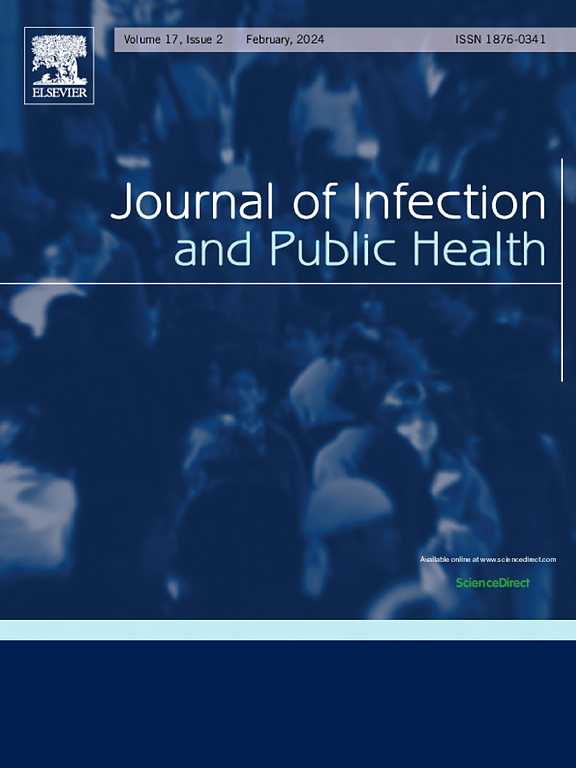Detection of blaTEM, blaOXA, blaCTX-M, and blaSHV genes of antibiotic resistance in diarrheagenic E. coli causing enteric infection in hypertensive patients at Laquintinie Hospital, Littoral Region of Cameroon
IF 4.7
3区 医学
Q1 INFECTIOUS DISEASES
引用次数: 0
Abstract
Background
Pathogenic Escherichia coli is one of the most common causes of acute watery diarrhea among children and adults in the developing world. The severity of infection by this bacterium is a product of many factors, including virulence properties and antimicrobial resistance. This study aimed to determine the distribution of different virulence genes of E. coli isolates in hypertensive and non-hypertensive patients and their association with some selected beta-lactam resistance genes.
Methods
At the Douala Laquintinie Hospital, 518 fecal samples were collected from both hypertensive and non-hypertensive patients with enteric infections. E. coli was isolated on eosin-methylene blue agar (EMB) and identified by the Api 20 E Galery. The virulence genes and extended-spectrum β-lactamase-producing (ESBL) E. coli genes were detected by simplex polymerase chain reaction (PCR), while antimicrobial susceptibility was tested by the Kirby-Bauer agar disc diffusion method.
Results
The prevalence of enteric infection due to diarrheagenic E. coli (n = 204) was found to be 39.38 % in the general population (n = 518). There were 55 enterovirulent E. coli isolates identified. According to hypertension (HTN), enteropathogenic E. coli (EPEC) isolates were more isolated in hypertensive patients (77.78 %) than in non-hypertensive patients (22.22 %), while enteroaggregative E. coli (EAEC) were the most frequent in non-hypertensive patients (58.33 %). EPEC, EAEC, enterotoxigenic E. coli (ETEC), and Shiga toxin-producing E. coli (STEC) isolates showed higher rates of resistance to amoxicillin (AMO) (90.48 %; 100.00 %; 100.00 %; 100.00 % vs 83.33 %; 85.71 %; 75.00 %; 50.00 %) and SXT (71.43 %; 80.00 %; 75.00 %; 75.00 % vs 0.00 %; 28.57 %; 50.00 %; 25.00 %) in hypertensive patients compared to non-hypertensive patients. The prevalence of ESBL-producing (ESBL-P) E. coli was 87.27 %. The resistance genes blaTEM (64.71 % vs 52.38 %) and blaOXA (23.53 % vs 9.52 %) were more frequently detected in hypertensive patients than in non-hypertensive patients. The high resistance to AMO was correlated with the presence of the blaCTX-M gene (OR: 5.52; 95 % CI: 0.61–49.39; p = 0.093).
Conclusion
This study reveals the high burden of the typical EPEC, EAEC, and ESBL-P E. coli and confirmed the high occurrence of blaCTX-M and blaTEM among ESBL-producing E. coli in hypertensive patients. The study suggests that measures need to be taken to reduce the harmfulness of enterovirulent E. coli and the resistance of enterovirulent E. coli in hypertensive patients.
喀麦隆沿海地区拉昆廷尼医院致高血压患者肠道感染致泻性大肠杆菌中blaTEM、blaOXA、blaCTX-M和blaSHV耐药基因的检测
背景:致病性大肠杆菌是发展中国家儿童和成人急性水样腹泻的最常见原因之一。这种细菌感染的严重程度是许多因素的产物,包括毒力特性和抗菌素耐药性。本研究旨在确定大肠杆菌在高血压和非高血压患者中不同毒力基因的分布及其与某些β -内酰胺耐药基因的关系。方法:在杜阿拉拉昆廷医院收集518例高血压和非高血压肠道感染患者的粪便样本。在伊红-亚甲基蓝琼脂(EMB)上分离到大肠杆菌,并通过Api 20 E gallery进行鉴定。采用单形聚合酶链式反应(PCR)检测大肠杆菌毒力基因和广谱产β-内酰胺酶(ESBL)基因,采用Kirby-Bauer琼脂盘扩散法检测其药敏。结果:普通人群(n = 518)中,致泻性大肠杆菌肠道感染发生率为39.38%(204例)。共分离出55株肠毒性大肠杆菌。根据高血压(HTN),高血压患者中肠致病性大肠杆菌(EPEC)的分离率(77.78%)高于非高血压患者(22.22%),而肠聚集性大肠杆菌(EAEC)的分离率(58.33%)高于非高血压患者(77.78%)。EPEC、EAEC、产肠毒素大肠杆菌(ETEC)和产志贺毒素大肠杆菌(STEC)对阿莫西林(AMO)的耐药率较高(90.48%;100.00%;100.00%;100.00% vs 83.33%;85.71%;75.00%;50.00%)和SXT (71.43%;80.00%;75.00%;75.00% vs . 0.00 %;28.57%;50.00%;25.00%),与非高血压患者相比。产esbl (ESBL-P)大肠杆菌的感染率为87.27%。耐药基因blaTEM (64.71% vs 52.38%)和blaOXA (23.53% vs 9.52%)在高血压患者中的检出率高于非高血压患者。对AMO的高抗性与blaCTX-M基因的存在相关(OR: 5.52;95% ci: 0.61-49.39;p = 0.093)。结论:本研究揭示了典型的EPEC、EAEC和ESBL-P大肠杆菌的高负荷,并证实了高血压患者产esbl大肠杆菌中blaCTX-M和blaTEM的高发生率。提示应采取措施降低大肠杆菌对高血压患者的危害,提高其耐药性。
本文章由计算机程序翻译,如有差异,请以英文原文为准。
求助全文
约1分钟内获得全文
求助全文
来源期刊

Journal of Infection and Public Health
PUBLIC, ENVIRONMENTAL & OCCUPATIONAL HEALTH -INFECTIOUS DISEASES
CiteScore
13.10
自引率
1.50%
发文量
203
审稿时长
96 days
期刊介绍:
The Journal of Infection and Public Health, first official journal of the Saudi Arabian Ministry of National Guard Health Affairs, King Saud Bin Abdulaziz University for Health Sciences and the Saudi Association for Public Health, aims to be the foremost scientific, peer-reviewed journal encompassing infection prevention and control, microbiology, infectious diseases, public health and the application of healthcare epidemiology to the evaluation of health outcomes. The point of view of the journal is that infection and public health are closely intertwined and that advances in one area will have positive consequences on the other.
The journal will be useful to all health professionals who are partners in the management of patients with communicable diseases, keeping them up to date. The journal is proud to have an international and diverse editorial board that will assist and facilitate the publication of articles that reflect a global view on infection control and public health, as well as emphasizing our focus on supporting the needs of public health practitioners.
It is our aim to improve healthcare by reducing risk of infection and related adverse outcomes by critical review, selection, and dissemination of new and relevant information in the field of infection control, public health and infectious diseases in all healthcare settings and the community.
 求助内容:
求助内容: 应助结果提醒方式:
应助结果提醒方式:


